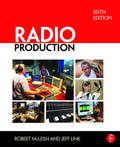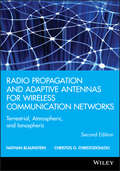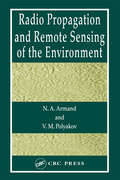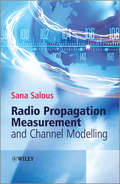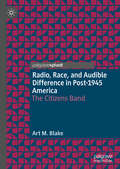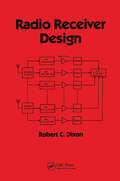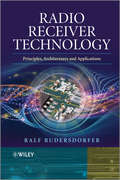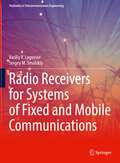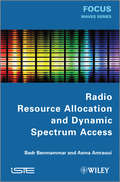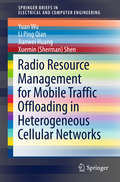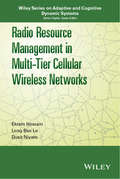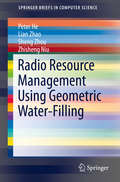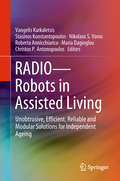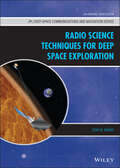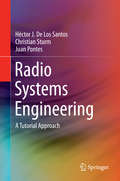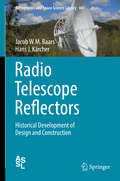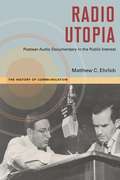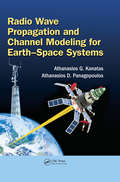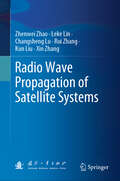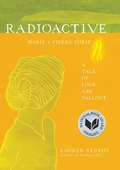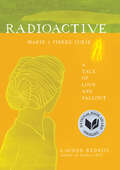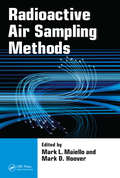- Table View
- List View
Radio Production: A Manual For Broadcasters (The\library Of Communication Techniques)
by Robert McLeish Jeff LinkRadio Production is for professionals and students interested in understanding the radio industry in today’s ever-changing world. This book features up-to-date coverage of the purpose and use of radio with detailed coverage of current production techniques in the studio and on location. In addition there is exploration of technological advances, including handheld digital recording devices, the use of digital, analogue and virtual mixing desks and current methods of music storage and playback. Within a global context, the sixth edition also explores American radio by providing an overview of the rules, regulations, and purpose of the Federal Communications Commission. The sixth edition includes: Updated material on new digital recording methods, and the development of outside broadcast techniques, including Smartphone use. The use of social media as news sources, and an expansion of the station’s presence. Global government regulation and journalistic codes of practice. Comprehensive advice on interviewing, phone-ins, news, radio drama, music, and scheduling. This edition is further enhanced by a companion website, featuring examples, exercises, and resources: www.focalpress.com/cw/mcleish.
Radio Propagation and Adaptive Antennas for Wireless Communication Networks
by Christos G. Christodoulou Nathan BlaunsteinExplores novel wireless networks beyond 3G, and advanced 4G technologies, such as MIMO, via propagation phenomena and the fundamentals of adapted antenna usage.Explains how adaptive antennas can improve GoS and QoS for any wireless channel, with specific examples and applications in land, aircraft and satellite communications.Introduces new stochastic approach based on several multi-parametric models describing various terrestrial scenarios, which have been experimentally verified in different environmental conditionsNew chapters on fundamentals of wireless networks, cellular and non-cellular, multiple access networks, new applications of adaptive antennas for positioning, and localization of subscribersIncludes the addition of problem sets at the end of chapters describing fundamental aspects of wireless communication and antennas.
Radio Propagation and Remote Sensing of the Environment
by N.A. Armand V.M. PolyakovThis book describes the processes of radio propagation and analyzes the equations that enable estimation of media. It explores propagation processes and related phenomena including absorption, refraction, reflection, and scattering. It also analyzes how knowledge of radiowave properties allows accurate estimations of media via inverse problems.
Radio Propagation Measurement and Channel Modelling
by Sana SalousWhile there are numerous books describing modern wireless communication systems that contain overviews of radio propagation and radio channel modelling, there are none that contain detailed information on the design, implementation and calibration of radio channel measurement equipment, the planning of experiments and the in depth analysis of measured data.The book would begin with an explanation of the fundamentals of radio wave propagation and progress through a series of topics, including the measurement of radio channel characteristics, radio channel sounders, measurement strategies, data analysis techniques and radio channel modelling. Application of results for the prediction of achievable digital link performance would be discussed with examples pertinent to single carrier, multi-carrier and spread spectrum radio links. This work would address specifics of communications in various different frequency bands for both long range and short range fixed and mobile radio links.
Radio Protocols for LTE and LTE-Advanced
by SeungJune Yi SungDuck Chun YoungDae Lee SungJun Park SungHoon JungProvides a unique focus on radio protocols for LTE and LTE-Advanced (LTE-A) Giving readers a valuable understanding of LTE radio protocols, this book covers LTE (Long-Term Evolution) Layer 2/3 radio protocols as well as new features including LTE-Advanced. It is divided into two sections to differentiate between the two technologies’ characteristics. The authors systematically explain the design principles and functions of LTE radio protocols during the development of mobile handsets. The book also provides essential knowledge on the interaction between mobile networks and mobile handsets. Among the first publications based on the 3GPP R10 specifications, which introduces LTE-A Beginning with an overview of LTE, topics covered include: Idle Mode Procedure; Packet Data Convergence Protocol and Public Warning Systems Presents the LTE radio interface protocol layers in a readable manner, to enhance the material in the standards publications From an expert author team who have been directly working on the 3GPP standards It is targeted at professionals working or intending to work in the area and can also serve as supplementary reading material for students who need to know how theory on the most extensively used mobile radio interface today is put into practice
Radio, Race, and Audible Difference in Post-1945 America: The Citizens Band
by Art M. BlakeIn the second half of the twentieth century, new sounds began to reverberate across the United States. The voices of African-Americans as well as of women, Latinx, queer, and trans people broke through in social movements, street protests, and in media stories of political and social disruption. Postwar America literally sounded different. This book argues that new technologies and new mobilities sharpened American attention to these audibly coded identities, on the radio, on the streets and highways, in new music, and on television. Covering the Puerto Rican migration to New York in the 1950s, the varying uses of CB radio by white and African American citizens in the 1970s, and the emergence of audible queerness, Art M. Blake attunes us to the sounds of race, mobility, and audible difference. As he argues, marginalized groups disrupted the postwar machine age by using new media technologies to make themselves heard.
Radio Receiver Design (Electrical and Computer Engineering)
by Robert DixonProvides a fundamental understanding of current as well as future concepts and techniques essential for systematically defining and manufacturing a receiver that is flexible yet functional in today's world. An excellent introduction to communications and the role of receivers in conveying information.
Radio Receiver Technology
by Ralf RudersdorferWritten by an expert in the field, this book covers the principles, architectures, applications, specifications and characterizations of radio receivers In this book, the author introduces the reader to the basic principles and theories of present-day communications receiver technology. The first section of the book presents realization concepts at the system level, taking into consideration the various types of users. Details of the circuitry are described providing the reader with an understanding of fully digitized radio receivers, offering an insight into the state-of-the-art. The remaining sections address radio receivers, particularly as two-port devices. Furthermore, the author outlines the fields of applications (with sample calculations and with reference to practical work) and their features and considers also the specialty of high-quality radio receivers. As can be seen from the multitude of terrestrial applications described in Part II, they are typically used for radio surveillance, signal intelligence, modern radio bearing and at the classical radio services. Parts III and IV describe the entire range of parameters that are useful for the characterization of these receivers. The description starts from the physical effect, or the explanation of the individual parameter, and then proceeds to the measuring technique for determining the parameters, highlighting problems, followed by explanatory notes with applicatory relevance. The measuring procedures described are the result of experiences gained in extended laboratory work and practical testing. With the model shown in Part IV, used for the operational evaluation detailing the intrinsic small range of interpretation, the book covers untreated research in the field. The Appendix provides among others valuable information about the dimensioning of receiving systems and the mathematical derivation of non-linear effects and as well as a useful method for converting different level specifications. Key Features: Introduces the basic principles and theories of present-day technologyDiscusses concepts at system level (aligned to the various types of users)Addresses (fully) digitized radio receivers focusing on the state-of-the-artClose contacts to the industry were utilized to show background informationEnables the reader to comprehend and evaluate the characteristic features and the performance of such systemsExamines the entire range of parameters that are characteristic of the technology including the physical effect and measuring techniquesIncludes results of experiences gained in extended laboratory work and practical testing with examplesProvides a uniform and systematic approach for ease of understanding e.g. many didactic figures for the visual illustration have been newly created as well as complete real-world examplesThis book will be an excellent resource to understand the principles of work, for professionals developing and testing radio receivers, for receiver users (e.g. at regulatory agencies, surveillance centers, secret services, classical radio communications services), technicians, engineers and technicians who work with RF-measurement instruments, postgraduate students studying in the field and university lecturers. Chartered radio amateurs and handlers/operators will also find this book insightful. Due to high level of detail, it also serves as a reference. By using the carefully edited alphabetical index with over 1,200 entries, the appropriate explanations can be found quickly in the text.
Radio Receivers for Systems of Fixed and Mobile Communications (Textbooks in Telecommunication Engineering)
by Vasiliy V. Logvinov Sergey M. SmolskiyThe textbook acquaints the reader with the architecture of receivers of analog and digital radio systems, helps to study the stages of designing a modern radio receiver and reveals the reasons and methods for its effective operation in networks for various purposes. Particular attention is paid to the methods of generating and processing signals in the receivers of digital systems with multiple access, which make it possible to provide data transfer rates close to the maximum possible (according to Shannon). As a textbook for students studying methods of optimal signal reception, the book will also be useful to specialists in the field of telecommunications involved in the development of radio receivers. The book shows how the development of theoretical, circuitry and integrated technologies led to the active introduction of algorithmic methods for signal processing changed both the design of receivers and the methods of forming the information flow in free space (MIMO, beamforming). The creation of a global 5G network based on heterogeneous networks puts forward new requirements for the architecture of receivers, which are determined by the requirements to achieve high data rates, low time delays or use in networks with coordinated multipoint transmission and reception (CoMP). To consolidate the knowledge gained, the book includes a complete set of materials for online classes, including questions and answers, a guide to solving problems for each chapter, and computer modeling units of receivers in the MicroCAP environment, based on preliminary calculations.
Radio Resource Allocation and Dynamic Spectrum Access (Focus Ser. #2)
by Badr Benmammar Asma AmraouiWe are currently witnessing an increase in telecommunications norms and standards given the recent advances in this field. The increasing number of normalized standards paves the way for an increase in the range of services available for each consumer. Moreover, the majority of available radio frequencies have already been allocated. This explains the emergence of cognitive radio (CR) – the sharing of the spectrum between a primary user and a secondary user. In this book, we will present the state of the art of the different techniques for spectrum access using cooperation and competition to solve the problem of spectrum allocation and ensure better management of radio resources in a radio cognitive context. The different aspects of research explored up until now on the applications of multi-agent systems (MAS) in the field of cognitive radio are analyzed in this book. The first chapter begins with an insight into wireless networks and mobiles, with special focus on the IEEE 802.22 norm, which is a norm dedicated to CR. Chapter 2 goes into detail about CR, which is a technical field at the boundary between telecommunications and Artificial Intelligence (AI). In Chapter 3, the concept of the “agent” from AI is expanded to MAS and associated applications. Finally, Chapter 4 establishes an overview of the use of AI techniques, in particular MAS, for its allocation of radio resources and dynamic access to the spectrum in CR. Contents 1. Wireless and Mobile Networks. 2. Cognitive Radio. 3. Multi-agent Systems. 4. Dynamic Spectrum Access. About the Authors Badr Benmammar has been Associate Professor at UABT (University Abou Bekr Belkaïd Tlemcen), Algeria since 2010 and was a research fellow at CNRS LaBRI Laboratory of the University of Bordeaux 1 until 2007. He is currently carrying out research at the Laboratory of Telecommunications of Tlemcen (LTT), UABT, Algeria. His main research activities concern the cognitive radio network, Quality of Service on mobile and wireless networks, end-to-end signaling protocols and agent technology. His work on Quality of Service has led to many publications in journals and conference proceedings. Asma Amraoui is currently a PhD candidate; she is preparing a doctoral thesis on a topic of research that explores the use of artificial intelligence techniques in cognitive radio networks. She is attached to the Laboratory of Telecommunications of Tlemcen (LTT) in Algeria.
Radio Resource Management for Mobile Traffic Offloading in Heterogeneous Cellular Networks
by Yuan Wu Li Ping Qian Jianwei Huang Xuemin Sherman ShenThis SpringerBrief offers two concrete design examples for traffic offloading. The first is an optimal resource allocation for small-cell based traffic offloading that aims at minimizing mobile users' data cost. The second is an optimal resource allocation for device-to-device assisted traffic offloading that also minimizes the total energy consumption and cellular link usage (while providing an overview of the challenging issues). Both examples illustrate the importance of proper resource allocation to the success of traffic offloading, show the consequent performance advantages of executing optimal resource allocation, and present the methodologies to achieve the corresponding optimal offloading solution for traffic offloading in heterogeneous cellular networks. The authors also include an overview of heterogeneous cellular networks and explain different traffic offloading paradigms ranging from uplink traffic offloading through small cells to downlink traffic offloading via mobile device-to-device cooperation. This brief is an excellent resource for postgraduate students studying advanced-level topics in wireless communications and networking. Researchers, engineers and professionals working in related fields will also find this brief a valuable resource tool.
Radio Resource Management in Multi-Tier Cellular Wireless Networks
by Ekram Hossain Long Bao Le Dusit NiyatoProviding an extensive overview of the radio resource management problem in femtocell networks, this invaluable book considers both code division multiple access femtocells and orthogonal frequency-division multiple access femtocells. In addition to incorporating current research on this topic, the book also covers technical challenges in femtocell deployment, provides readers with a variety of approaches to resource allocation and a comparison of their effectiveness, explains how to model various networks using Stochastic geometry and shot noise theory, and much more.
Radio Resource Management in Wireless Networks
by Ekram Hossain Mehdi Rasti Long Bao LeDo you need to design efficient wireless communications systems? This unique text provides detailed coverage of radio resource allocation problems in wireless networks and the techniques that can be used to solve them. Covering basic principles and mathematical algorithms, and with a particular focus on power control and channel allocation, you will learn how to model, analyze, and optimize the allocation of resources in both physical and data link layers, and for a range of different network types. Both established and emerging networks are considered, including CDMA and OFDMA wireless networks, relay-based wireless networks, and cognitive radio networks. Numerous exercises help you put knowledge into practice, and provide the tools needed to address some of the current research problems in the field. This is an essential reference whether you are a graduate student, researcher or industry professional working in the field of wireless communication networks.
Radio Resource Management Using Geometric Water-Filling
by Peter He Lian Zhao Sheng Zhou Zhisheng NiuThis brief introduces the fundamental theory and development of managing radio resources using a water-filling algorithm that can optimize system performance in wireless communication. Geometric Water-Filling (GWF) is a crucial underlying tool in emerging communication systems such as multiple input multiple output systems, cognitive radio systems, and green communication systems. Early chapters introduce emerging wireless technologies and provide a detailed analysis of water-filling. The brief investigates single user and multi-user issues of radio resource management, allocation of resources, and energy harvesting. Effective algorithms demonstrate the incredible potential capabilities of water-filling mechanisms. This brief is designed for researchers and professionals working with resource management and wireless communications. Advanced-level students in computer science and engineering will also find the information valuable.
RADIO--Robots in Assisted Living: Unobtrusive, Efficient, Reliable and Modular Solutions for Independent Ageing
by Vangelis Karkaletsis Stasinos Konstantopoulos Nikolaos S. Voros Roberta Annicchiarico Maria Dagioglou Christos P. AntonopoulosThis book describes a unique approach to bring robotic technology into elders’ daily lives. Low cost components and low cost robotic assistants are effectively combined to offer high quality services to elders and people in need. The book presents in a comprehensive way how technology can be used for developing a new healthcare paradigm where high quality services are offered at home, thus reducing the ever-increasing hospitalization cost of the elders and the people with chronic diseases.
Radio Science Techniques for Deep Space Exploration (JPL Deep-Space Communications and Navigation Series)
by Sami W. AsmarExplore the development and state-of-the-art in deep space exploration using radio science techniques In Radio Science Techniques for Deep Space Exploration, accomplished NASA/JPL researcher and manager Sami Asmar delivers a multi-disciplinary exploration of the science, technology, engineering, mission operations, and signal processing relevant to deep space radio science. The book discusses basic principles before moving on to more advanced topics that include a wide variety of graphical illustrations and useful references to publications by experts in their respective fields. Complete explanations of changes in the characteristics of electromagnetic waves and the instrumentation and technology used in scientific experiments are examined. Radio Science Techniques for Deep Space Exploration offers answers to the question of how to explore the solar system with radio links and better understand the interior structures, atmospheres, rings, and surfaces of other planets. The author also includes: Thorough introductions to radio science techniques and systems needed to investigate planetary atmospheres, rings, and surfaces Comprehensive explorations of planetary gravity and interior structures, as well as relativistic and solar studies Practical discussions of instrumentation, technologies, and future directions in radio science techniques Perfect for students and professors of physics, astronomy, planetary science, aerospace engineering, and communications engineering, Radio Science Techniques for Deep Space Exploration will also earn a place in the libraries of engineers and scientists in the aerospace industry.
Radio Systems Engineering
by Steven W. EllingsonUsing a systems framework, this textbook provides a clear and comprehensive introduction to the performance, analysis and design of radio systems for students and practising engineers. Presented within a consistent framework, the first part of the book describes the fundamentals of the subject: propagation, noise, antennas and modulation. The analysis and design of radios, including RF circuit design and signal processing, is covered in the second half of the book. The former is presented with minimal involvement of Smith charts, enabling students to grasp the fundamentals more readily. Both traditional and software-defined/direct sampling technology are described, with pros and cons of each strategy explained. Numerous examples within the text involve realistic analysis and design activities, and emphasize how practical experiences may differ from theory or taught procedures. End-of-chapter problems are provided, as are a password-protected solutions manual and lecture slides to complete the teaching package for instructors.
Radio Systems Engineering
by Héctor J. De Los Santos Christian Sturm Juan PontesThis book is intended for readers who already have knowledge of devices and circuits for radio-frequency (RF) and microwave communication and are ready to study the systems engineering-level aspects of modern radio communications systems. The authors provide a general overview of radio systems with their components, focusing on the analog parts of the system and their non-idealities. Based on the physical functionality of the various building blocks of a modern radio system, block parameters are derived, which allows the examination of their influence on the overall system performance. The discussion is complemented by tutorial exercises based on the Agilent SystemVue electronic system-level (ESL) design software. With these tutorials, readers gain practical experience with realistic design examples of radio transmission systems for communications and radar sensing. The tutorials cover state-of-the-art system standards and applications and consider the characteristics of typical radio-frequency hardware components. For all tutorials, a comprehensive description of the tasks, including some hints to the solutions, is provided. The readers are then able to perform these tasks independently. A complete set of simulation models and solutions to the tutorial exercises is given.
Radio Telescope Reflectors: Historical Development of Design and Construction (Astrophysics and Space Science Library #447)
by Jacob W.M. Baars Hans J KärcherThis book demonstrates how progress in radio astronomy is intimately linked to the development of reflector antennas of increasing size and precision. The authors describe the design and construction of major radio telescopes as those in Dwingeloo, Jodrell Bank, Parkes, Effelsberg and Green Bank since 1950 up to the present as well as millimeter wavelength telescopes as the 30m MRT of IRAM in Spain, the 50m LMT in Mexico and the ALMA submillimeter instrument. The advances in methods of structural design and coping with environmental influences (wind, temperature, gravity) as well as application of new materials are explained in a non-mathematical, descriptive and graphical way along with the story of the telescopes. Emphasis is placed on the interplay between astronomical and electromagnetic requirements and structural, mechanical and control solutions. A chapter on management aspects of large telescope projects closes the book. The authors address a readership with interest in the progress of engineering solutions applied to the development of radio telescope reflectors and ground station antennas for satellite communication and space research. The book will also be of interest to historians of science and engineering with an inclination to astronomy.
Radio Utopia: Postwar Audio Documentary in the Public Interest
by Matthew C. EhrlichAs World War II drew to a close and radio news was popularized through overseas broadcasting, journalists and dramatists began to build upon the unprecedented success of war reporting on the radio by creating audio documentaries. Focusing particularly on the work of radio luminaries such as Edward R. Murrow, Fred Friendly, Norman Corwin, and Erik Barnouw, Radio Utopia: Postwar Audio Documentary in the Public Interest traces this crucial phase in American radio history, significant not only for its timing immediately before television, but also because it bridges the gap between the end of the World Wars and the beginning of the Cold War. Matthew C. Ehrlich closely examines the production of audio documentaries disseminated by major American commercial broadcast networks CBS, NBC, and ABC from 1945 to 1951. Audio documentary programs educated Americans about juvenile delinquency, slums, race relations, venereal disease, atomic energy, arms control, and other issues of public interest, but they typically stopped short of calling for radical change. Drawing on rare recordings and scripts, Ehrlich traces a crucial phase in the evolution of news documentary, as docudramas featuring actors were supplanted by reality-based programs that took advantage of new recording technology. Paralleling that shift from drama to realism was a shift in liberal thought from dreams of world peace to uneasy adjustments to a cold war mentality. Influenced by corporate competition and government regulations, radio programming reflected shifts in a range of political thought that included pacifism, liberalism, and McCarthyism. In showing how programming highlighted contradictions within journalism and documentary, Radio Utopia reveals radio's response to the political, economic, and cultural upheaval of the post-war era.
Radio Wave Propagation and Channel Modeling for Earth-Space Systems
by Athanasios G. Kanatas Athanasios D. PanagopoulosThe accurate design of earth–space systems requires a comprehensive understanding of the various propagation media and phenomena that differ depending on frequencies and types of applications. The choice of the relevant channel models is crucial in the design process and constitutes a key step in performance evaluation and testing of earth–space systems. The subject of this book is built around the two characteristic cases of satellite systems: fixed satellites and mobile satellite systems. <P><P>Radio Wave Propagation and Channel Modeling for Earth–Space Systems discusses the state of the art in channel modeling and characterization of next-generation fixed multiple-antennas and mobile satellite systems, as well as propagation phenomena and fade mitigation techniques. The frequencies of interest range from 100 MHz to 100 GHz (from VHF to W band), whereas the use of optical free-space communications is envisaged.Examining recent research advances in space-time tropospheric propagation fields and optical satellite communication channel models, the book covers land mobile multiple antennas satellite- issues and relative propagation campaigns and stratospheric channel models for various applications and frequencies. It also presents research and well-accepted satellite community results for land mobile satellite and tropospheric attenuation time-series single link and field synthesizers.The book examines aeronautical communications channel characteristics and modeling, relative radio wave propagation campaigns, and stratospheric channel model for various applications and frequencies. Propagation effects on satellite navigation systems and the corresponding models are also covered.
Radio Wave Propagation of Satellite Systems
by Zhenwei Zhao Leke Lin Changsheng Lu Rui Zhang Kun Liu Xin ZhangThis book highlights the fundamental theories and prediction methods of radiowave propagation for the design, building, and operation of contemporary satellite systems. The primary objective of this book is to inquire into whether and how it is possible in a democracy to effectively decrease short-sighted policies. Although the commonplace expression “responsibility to future generations” has become firmly established in public and political vocabulary, its operational meaning and practice are not as well understood and have not yet been systematically evaluated. It still has not been successfully translated into viable ethical and theoretical concepts that can guide public policies and action. How can modes of governance and established priorities compatible with the well-being of future generations be created? This book identifies the conditions, and the obstacles, for such future-oriented governance. To meet the needs of diverse satellite applications, the book covers the main factors that affect radiowave propagation, including the clear-air effects, the hydrometeor effects, the ionospheric effects, the earth's surface reflection, and the local environmental effects. To enhance the prediction of radiowave propagation, the book elaborates on the characteristics of radio meteorological and ionospheric environments. It also summarizes research progress on the prediction methods of radio noise and interference coordination for satellite systems. The fade mitigation techniques and the propagation analysis of satellite system design are discussed. Providing a comprehensive summary of common practices and latest advances, the book is intended for researchers and engineers engaged in the study and practice of satellite systems, radio propagation, and its applications.
Radioactive: Marie And Pierre Curie - A Tale Of Love And Fallout
by Lauren RednissIn 1891, 24-year-old Marie Sklodowska moved from Warsaw to Paris, where she found work in the laboratory of Pierre Curie, a scientist engaged in research on heat and magnetism. They fell in love. They took their honeymoon on bicycles. They expanded the periodic table, discovering two new elements with startling properties, radium and polonium. They recognized radioactivity as an atomic property, heralding the dawn of a new scientific era. They won the Nobel Prize. Newspapers mythologized the couple's romance, beginning articles on the Curies with "Once upon a time... " Then, in 1906, Pierre was killed in a freak accident. Marie continued their work alone. She won a second Nobel Prize in 1911, and fell in love again, this time with the married physicist Paul Langevin. Scandal ensued. Duels were fought.<P><P> In the century since the Curies began their work, we've struggled with nuclear weapons proliferation, debated the role of radiation in medical treatment, and pondered nuclear energy as a solution to climate change. In Radioactive, Lauren Redniss links these contentious questions to a love story in 19th Century Paris.<P> Radioactive draws on Redniss's original reporting in Asia, Europe and the United States, her interviews with scientists, engineers, weapons specialists, atomic bomb survivors, and Marie and Pierre Curie's own granddaughter.<P> Whether young or old, scientific novice or expert, no one will fail to be moved by Lauren Redniss's eerie and wondrous evocation of one of history's most intriguing figures.
Radioactive: Marie & Pierre Curie: A Tale of Love and Fallout
by Lauren RednissA visual journey into the life of Marie Curie, as told through the dazzling collage style of acclaimed author and artist Lauren Redniss “Lauren Redniss creates an entirely new genre of biography.” —Nylon“Visually dazzling…a startlingly original graphic style.” —SlateThe name Marie Curie is enshrined in every schoolchild’s mind as one of the earliest and most inspirational female pioneers in the history of science. Yet the rich, vivid, and romantic story of Marya Salome Sklodwska—the young Polish national who discovered radioactivity—has been lost to time . . . until now, in the pages of this stunning, wildly creative, and uniquely moving visual biography by one of the most creative artistic talents working today. Lauren Redniss, a celebrated New York Times illustrator and storyteller, has thrown herself deeply and passionately into researching the story of the real Marie Curie; of her passionate and tragic romantic life; and of the century of scientific innovation and controversy that sprang from her discovery of radium and went on to change the course of world history. Drawing on her original archival research in Europe and the United States—and a host of new interviews with Curie family members and scientists who carry on the Curie tradition—Redniss has created a fascinating and deeply moving book. A visually stunning work of illustrative art, Radioactive walks the reader through the story of Curie’s own life, which was marked by both extraordinary scientific discovery and dramatic personal trauma—from her romantic partnership with Pierre, through his tragic decline from radium poisoning and death in a traffic accident, to the scandalous affair with another fellow scientist that almost cost her her second Nobel Prize. But it also casts an eye forward, to survey the changes wrought by Curie’s discovery of radioactivity—illuminating the path from the Curie laboratory past the bright red mushroom clouds in the Nevada desert through Three Mile Island and the advance in radiation therapy and nuclear power today. Whether young or old, scientific novice or expert, no one will fail to be moved by Lauren Redniss’s eerie and wondrous evocation of one of history’s most intriguing figures.
Radioactive Air Sampling Methods
by Mark L. Maiello Mark D. HooverAlthough the field of radioactive air sampling has matured and evolved over decades, it has lacked a single resource that assimilates technical and background information on its many facets. Edited by experts and with contributions from top practitioners and researchers, Radioactive Air Sampling Methods provides authoritative guidanc
